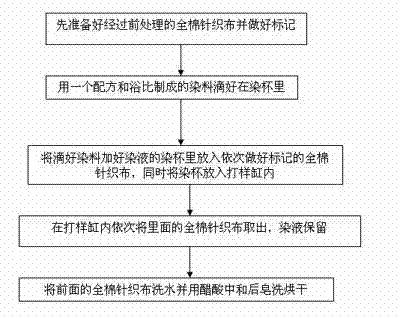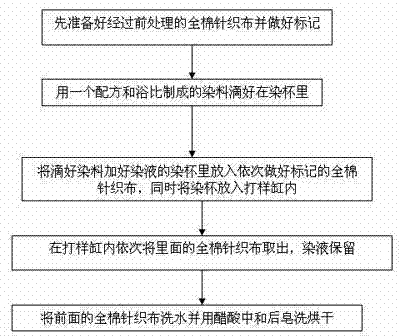Stepped coloring process of reactive dye
A reactive dye and process technology, applied in the field of reactive dye step-by-step coloring process, can solve the problems of high energy consumption, complicated process, poor quality of cotton dyed cloth, etc., and achieve the effect of improving quality, ensuring quality and reducing cost
- Summary
- Abstract
- Description
- Claims
- Application Information
AI Technical Summary
Problems solved by technology
Method used
Image
Examples
Embodiment Construction
[0011] The preferred embodiments of the present invention will be described in detail below in conjunction with the accompanying drawings, so that the advantages and features of the present invention can be more easily understood by those skilled in the art, so as to define the protection scope of the present invention more clearly.
[0012] The invention relates to a step-by-step coloring process of reactive dyes, see figure 1 : (1) Prepare the pre-treated cotton knitted fabric and mark it; (2) Drip the dye made with a formula and bath ratio in the dyeing cup; (3) Add the dyed dye to the dyeing cup Put the cotton knitted fabrics marked in turn into the dyeing cups of the liquid; at the same time, put the dyeing cups into the proofing tank; (4) take out the cotton knitted fabrics in the proofing tank one by one, and keep the dyeing solution; (5 ) Wash the front cotton knitted fabric with water, neutralize it with acetic acid, soap it and dry it.
[0013] Specific examples are...
PUM
 Login to View More
Login to View More Abstract
Description
Claims
Application Information
 Login to View More
Login to View More - R&D
- Intellectual Property
- Life Sciences
- Materials
- Tech Scout
- Unparalleled Data Quality
- Higher Quality Content
- 60% Fewer Hallucinations
Browse by: Latest US Patents, China's latest patents, Technical Efficacy Thesaurus, Application Domain, Technology Topic, Popular Technical Reports.
© 2025 PatSnap. All rights reserved.Legal|Privacy policy|Modern Slavery Act Transparency Statement|Sitemap|About US| Contact US: help@patsnap.com


